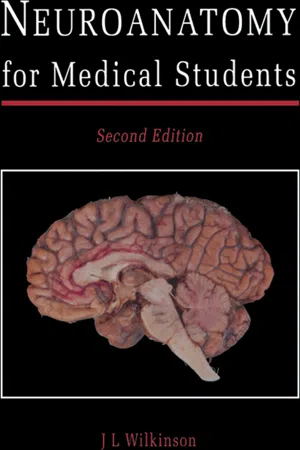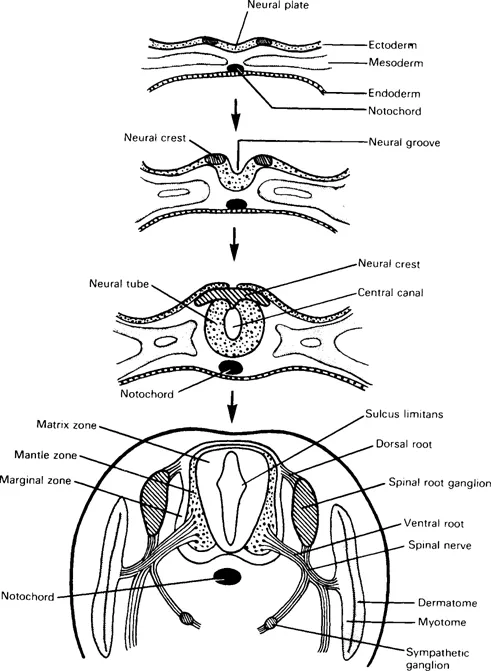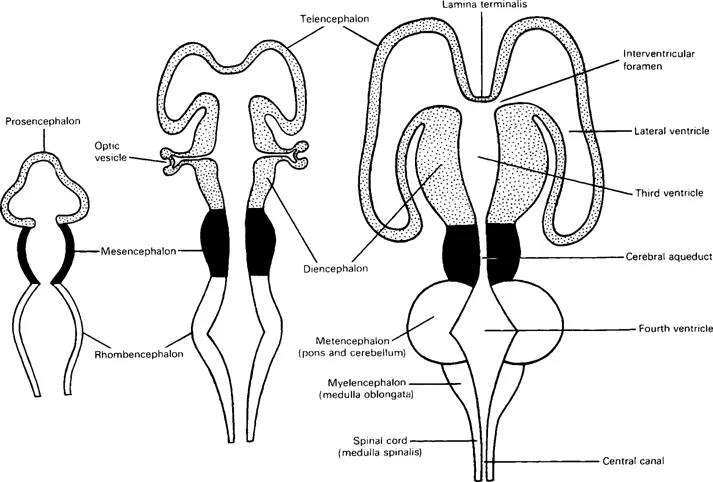Development
An understanding of development helps to explain the nervous system’s organization (Fig. 1.1). In the early embryonic disc, ectoderm overlying the newly-formed notochord thickens to form a midline neural plate. The edges of the neural plate become elevated as folds, creating a neural groove. Fusion of these folds extends caudally from the cervical region, creating a neural tube, with small openings, the neuropores, at its rostral and caudal ends, which close by the end of the fourth intrauterine week. Vertebral bodies develop around the notochord, which persists as the nucleus pulposus of intervertebral discs. (Incomplete closure of the caudal neuropore and defective development of associated vertebral arches produce spina bifida). The lateral margins of the neural plate comprise specialized neural crest cells; neural tube formation segregates these, and in the process of embryonic segmentation they become dorsal root ganglia. (Other neural crest cells provide neurolemmal sheath cells for spinal nerve fibres or migrate to become sympathetic ganglion cells and chromaffin cells of suprarenal medulla.) The rostral part of the neural tube enlarges into forebrain, midbrain and hindbrain vesicles; the remainder remains cylindrical as the spinal cord; neural proliferation in its walls eventually narrows the lumen to a minute central canal.
Fig. 1.1 Transverse sections showing progressive differentiation of the neural tube and associated structures.
The spinal cord
Details of histogenesis are beyond this brief account. Transverse sections of the neural tube reveal three layers (Fig. 1.1). The inner matrix zone is a wide germinal layer, its numerous cells undergoing mitosis; it produces neuroblasts and spongioblasts, the former developing into neurons, the latter into neuroglial cells (astrocytes and oligodendrocytes). The neuroblast cell bodies migrate outwards and form a surrounding mantle zone, the future spinal grey matter; their axons pass out further into a marginal zone, the future white matter. Central processes from the dorsal root ganglia grow into the neural tube; some ascend in the marginal zone, while others synapse with neurons in the mantle zone. When cell differentiation is complete, the residual cells of the matrix zone form the ependymal lining of the central canal.
The dorsal and ventral walls of the neural tube remain thin as roof and floor plates. On each side the wide mantle zone is demarcated into dorsal (alar) and ventral (basal) regions by an inner longitudinal sulcus limitans. Neurons of the alar lamina are functionally sensory (afferent). Neurons of the basal lamina are motor (efferent), their axons leaving the spinal cord as ventral roots which, with peripheral processes of the dorsal root ganglia, form spinal nerves (Fig. 1.2).
Fig. 1.2 Transverse sections of developing spinal cord showing (A) four cell columns in grey matter; (B) mature (thoracic) spinal cord.
Alar and basal laminae are subdivided into four longitudinal cell columns with specific functions. These grey columns are seen as ‘horns’ in cross-sections of a mature cord. The two afferent columns of each alar lamina receive axons from the dorsal root ganglia. Axons from the efferent columns form ventral nerve roots.
The general somatic afferent column (‘ordinary’ sensation) extends throughout the spinal cord and occupies most of the dorsal horn. It receives impulses from superficial (cutaneous) and deep (proprioceptive) receptors.
The general visceral afferent column (visceral sensation) at the base of the dorsal horn of cord segments T1–L2 and S2–4, receives impulses from viscera and blood vessels.
The general visceral efferent column (to smooth muscle) provides autonomic innervation for viscera, glands and blood vessels. Sympathetic outflow is from a lateral horn (T1–L2). Parasympathetic outflow is via certain cranial nerves and from S2–4 spinal segments. These fibres are termed ‘preganglionic’ because they all synapse in ganglia before reaching their targets.
The general somatic efferent column (to skeletal muscle) extends throughout the spinal cord in the ventral horn.
These four columns are termed ‘general’ because additional ‘special’ components are required in the brainstem for faculties such as taste and hearing. Aggregations of nerve cell bodies (somata), visible in transverse sections of grey matter, are often referred to as ‘nuclei’; each nucleus has particular functions and its neurons share common pathways.
Developmentally one cord segment (neuromere) serves one myotome and one dermatome on each side. In contrast to the very obvious segmentation of mesodermal somites, embryonic cord segments are not distinctly separated from one another because the developing cord must have internal structural continuity. Functional segmentation is marked externally by the attachments of pairs of spinal nerves.
Initially the spinal cord and vertebral canal are of equal length, but the former grows less rapidly; at birth its caudal end is level with the third lumbar vertebra and in adults reaches only to the disc between the first and second lumbar vertebrae. The more caudal spinal nerve roots are therefore elongated and pass obliquely within the canal before emerging via intervertebral foramina; beyond the spinal cord’s tip the vertebral canal contains a bundle of lumbar, sacral and coccygeal roots descending to their respective foramina.
Three membranes, derived from mesenchyme, surround the brain and spinal cord; these meninges are termed, from within outwards, pia mater, arachnoid mater and dura mater, and will be described later.
The brain
Three brain vesicles in the rostral part of the neural tube indicate the early division of the latter into forebrain (prosencephalon), midbrain (mesencephalon) and hindbrain (rhombencephalon) (Fig. 1.3); their cavities become ventricles in the mature brain. Three flexures appear in this region (Fig. 1.4); two are convex dorsally, a cephalic flexure (at midbrain level) and a cervical flexure (at the junction of hindbrain and spinal cord). A pontine flexure, concave dorsally, produced by unequal growth at future pontine level, has a buckling effect, everting the lateral walls and attenuating the roof of the neural tube here (Fig. 1.5 and see Fig. 5.4). The sensory alar laminae thus become lateral to the motor basal laminae in the floor of a rhomboid-shaped fossa (hence the name rhombencephalon). The part of the hindbrain caudal to the pontine flexure is the myelencephalon (future medulla oblongata); the rostral part, from which the pons and cerebellum develop, is the metencephalon; the hindbrain cavity becomes the fourth ventricle. In contrast, the mesencephalic cavity remains narrow as the cerebral aqueduct. The forebrain vesicle develops bilateral outgrowths which together constitute the telencephalon (= ‘end-brain’); these overgrow and cover the original forebrain, which becomes the diencephalon (= ‘between-brain’). The twin cavities of telencephalon develop into two lateral ventricles; the midline cavity of diencephalon is the third ventricle.
Fig. 1.3 Diagrams of stages in the differentiation of cerebral vesicles and the ventricular system.
Fig. 1.4 Diagram of the external form of a devel...




